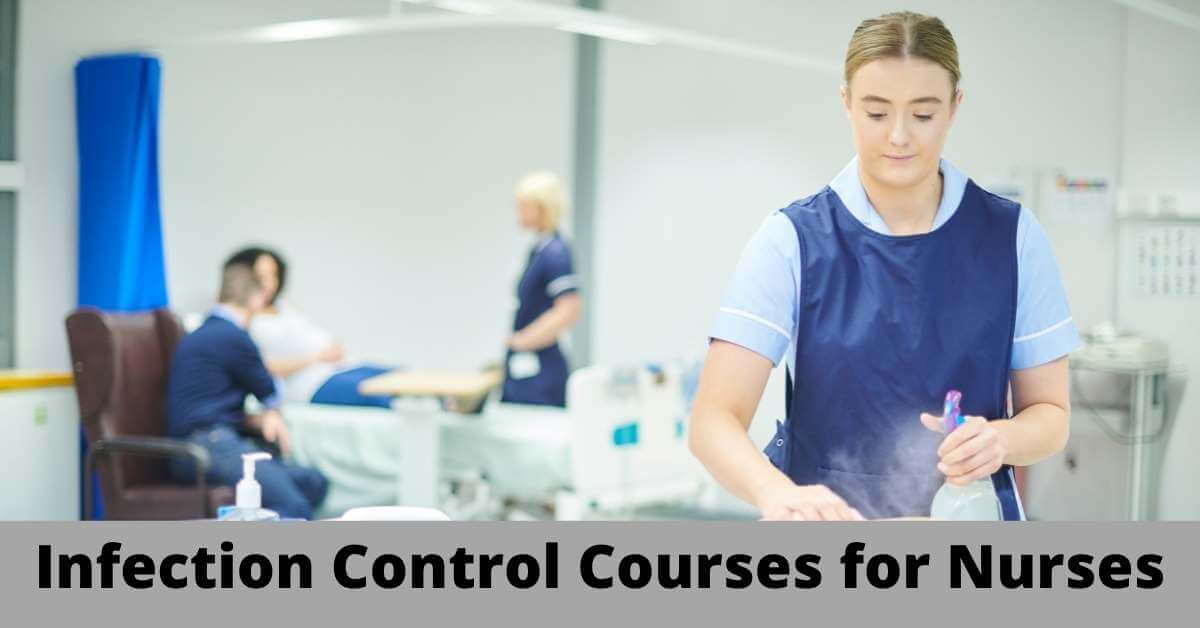Definition and Overview
Infection control courses for nurses aimed to prevents or stops the spread of infections in healthcare settings. The course teaches how infections spread, ways to prevent the spread of infections, and more detailed recommendations by type of healthcare setting.
Infection control is a practical, evidence-based approach which prevents patients and nurses from being harmed by avoidable infection and as a result of antimicrobial resistance.
Types of infection control
There are 7 major types of infection control
1. Hand Hygiene
- Perform hand hygiene by rubbing or washing hands
- Ensure the availability of hand-washing facilities with clean running water
- Ensure the availability of hand hygiene products (clean water, soap, single use clean towels, alcohol-based hand rub).
- Hand washing (40-60 seconds); wet hands and apply soap; rub all surfaces; rinse hands and thoroughly dry with a single-use towel; use towel to turn off faucet
Nursing revalidation provides best Infection control online course.
2. Environmental Cleaning
- Use appropriate cleaning and disinfection procedures for environmental and other frequently touched surfaces.
3. Patient Care Equipment
- Handle blood, body fluids, secretions, and excretions-soiled equipment in a way that prevents skin and mucous membrane exposure, clothing contamination, and pathogen transmission to other patients or the environment.
- Before using reusable equipment with another patient, thoroughly clean, disinfect, and reprocess it.
4. Waste Disposal
- Ensure safe sewage treatment
- In accordance with local regulations, treat waste contaminated with blood, bodily fluids, secretions, and excretions as clinical waste.
- By using non-contact thermometers, the need for single-use plastic probe covers is eliminated. These plastic probe covers, which are required by traditional contact thermometers, must be changed after each use and incinerated because they are considered medical waste. This is both expensive and extremely harmful to the environment.
Nursing revalidation provides best Infection control online course.
5. Linens
- Handle, transport, and process used linen in a way that prevents skin and mucous membrane exposures, as well as clothing contamination.
- Avoids pathogen transfer to other patients and/or the environment.
6. Gloves
· Wear when coming into contact with mucous membranes, nonintact skin, body fluids, secretions, excretions, or blood.
· After contact with potentially infectious material, switch between tasks and procedures on the same patient.
· Remove after use, before touching non-contaminated items or surfaces, and before proceeding to the next patient. Hand hygiene should be performed immediately after removal.
7. Facial Protection (Eyes, Nose and Mouth)
- Wear a surgical or procedure mask and eye protection (face shield, goggles) to prevent mucous membranes of the eyes, nose and mouth during activities that are likely to generate splashes or sprays of blood, body fluids, secretions and excretions
How does the infection spread?
Infectious diseases are illnesses caused by organisms like bacteria, viruses, fungi, or parasites. Many organisms inhabit and live on our bodies. They are usually harmless or even beneficial. However, some organisms can cause disease under certain conditions.
Some infectious diseases are transmissible from person to person. Some are spread by insects and other animals. You can get others by eating contaminated food or drinking contaminated water, or by being exposed to organisms in the environment.
An infection occurs when germs enter the body, increase in number, and cause a reaction of the body.
Three things are necessary for an infection to occur:
- Source: Places where infectious agents (germs) live (e.g., sinks, surfaces, human skin)
- Susceptible Person with a way for germs to enter the body
- Transmission: a way germ are moved to the susceptible person
How to control the infection?
Infection control in health care and public health practise settings includes a variety of measures to prevent and control the spread of infectious disease. Among these measures are:
- Hand Washing
- Infection control standard, contact, droplet and airborne precautions
- Procedures for decontamination of persons and disinfection of equipment and the environment
- Quarantine of contacts (if necessary)
- Prophylaxis of exposed individuals
- Control of the vectors of infection
Infection control online course
Nursing revalidation provides best Infection control online course.
This course will start by defining infection prevention and control and explaining the impact of good and bad infection control. It then goes into detail about the legislation that applies to infection control, the different types of microorganisms, how bacteria are transmitted, the chain of infection, and much more.
Conclusion
Infection control for nurses helps them to practice for halting the spread of viruses and bacteria and delivers top care to patients who have contracted infectious diseases. This training enables strong attention to detail, the ability to work well under pressure, and excellent communication skills.


Do you masters in infection control for nurses as fulltime